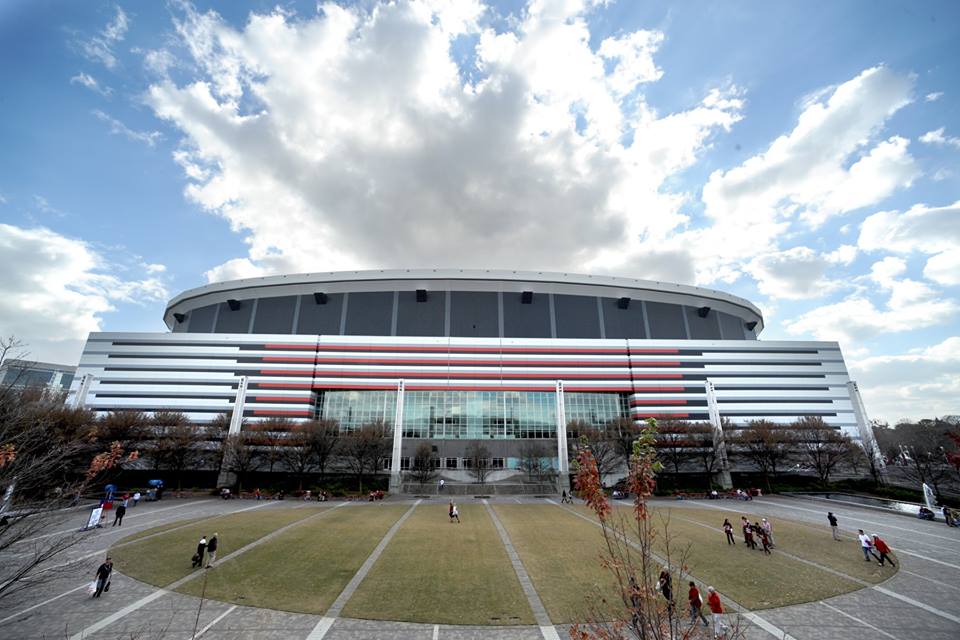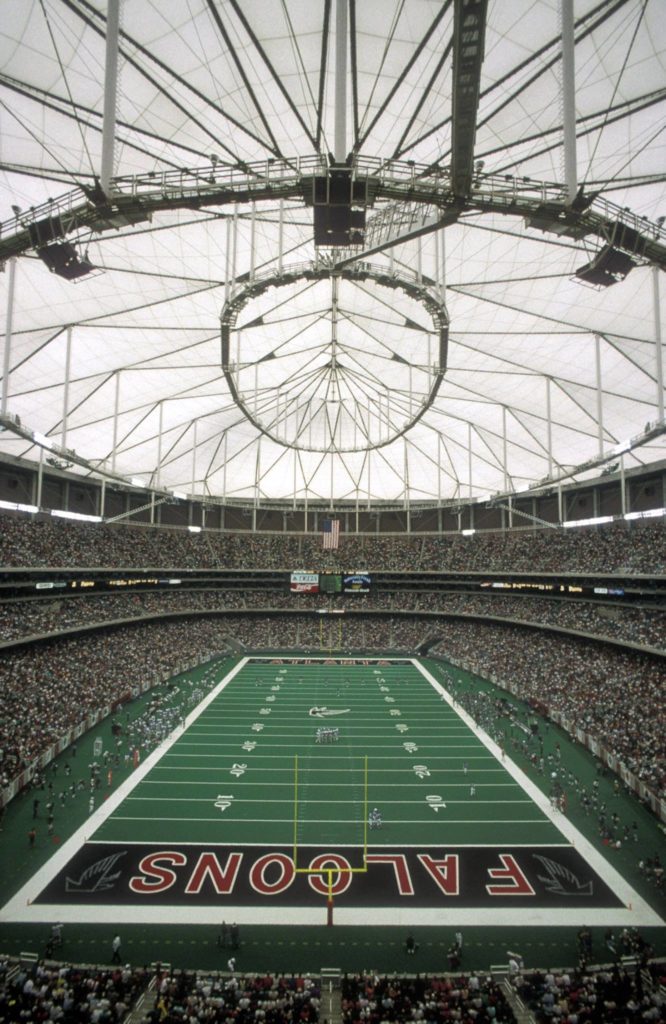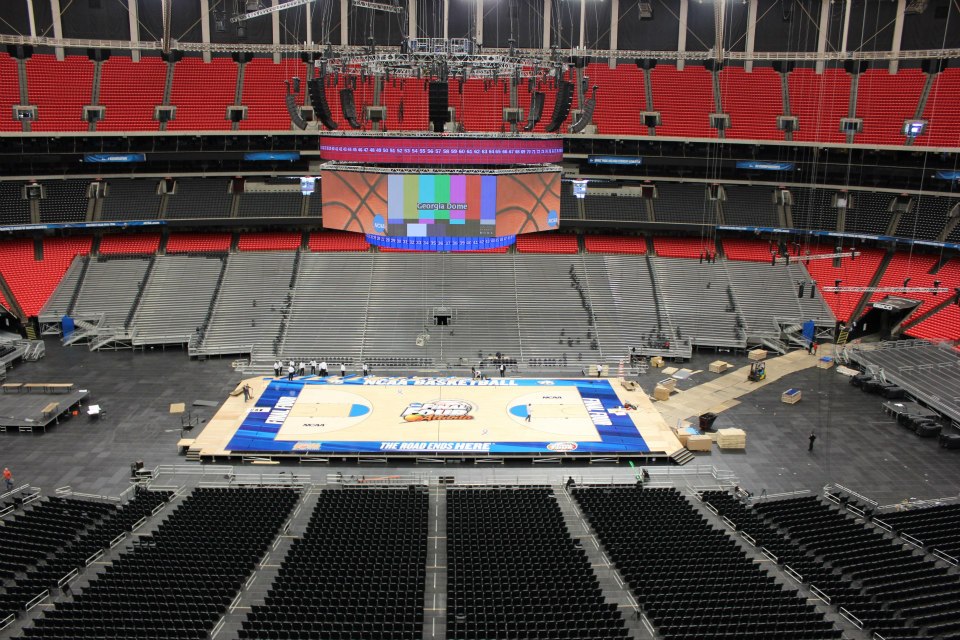On Sunday, the Georgia Dome will host its 25th and final opener for the Atlanta Falcons. Following this season, the Falcons will move to the new Mercedes-Benz Stadium, which is currently rising in the shadow of its predecessor.
The arrival of Mercedes-Benz Stadium will mark an unceremonious departure for the Georgia Dome, which will likely be reduced to rubble by the 2017 NFL season. That the anticipation of Mercedes-Benz Stadium’s arrival outweighs sadness over the Georgia Dome’s ending is not a surprise—time goes on, and the Georgia Dome was thought by some to be becoming increasingly obsolete by NFL standards. However, it is worth remembering that back when the Georgia Dome opened in 1992, it was viewed as something of a marvel.
Starting in the late 1980’s, the Falcons sought to leave the multipurpose Atlanta Fulton County Stadium and move into a modern facility that gave them more financial flexibility. Owner Rankin Smith said that without a new stadium, he would look to move the team elsewhere.
The State of Georgia sought to meet Smith’s demands, with governor Joe Frank Harris emerging as one of the project’s most prominent proponents. Eventually it was decided that a new stadium for the Falcons would not merely be a football facility. Rather, it was to be a large multipurpose structure that, in tandem with the adjacent Georgia World Congress Center, would attract events and visitors to downtown Atlanta.
The end result with a facility that included significant involvement from the State of Georgia. The final cost wound up being $214 million—$361 million in today’s dollars—and the structure was both large and striking enough to catch attention beyond the sports world.
“When spectators get their first glimpse inside the dome this August during an exhibition game of the Atlanta Falcons football team, they will no doubt look up and marvel,” wrote Steven W. Setzer in a March 1992 edition of Engineering News Record. “Covered by acres of fabric, an intricate network of cables and posts supports a 395,000-sq.ft. clear-span roof. The vast space has an airy feeling, with daylight diffusing through the big top.”
Constructing the dome was no small task, and even today it stands as a notable feat, as the Georgia Dome was the world’s largest cable-supported dome. The Georgia Dome was also meant to standout amidst the Atlanta skyline, as the stadium matches the height of a 29-story tall building.
For an extended period of time, the Georgia Dome made its impact felt across multiple sports. The Falcons made the playoffs twice before the end of the 1990’s, with the Georgia Dome finally getting a shot to host a postseason game in 1999. In that game, the Falcons staved off a late comeback by the San Francisco 49ers to win 20-18. That set the stage for the following week’s thrilling NFC Championship at the Metrodome, where the Falcons defeated the Minnesota Vikings 30-27 in overtime, allowing them to advance to the Super Bowl, which they lost to the Denver Broncos.
Though the home team did not return to the big game, the Georgia Dome was in the Super Bowl spotlight the following year. On January 30, 2000, the stadium hosted the thrilling Super Bowl XXXIV between the St. Louis Rams and the Tennessee Titans, a game that saw the Rams stop the Titans just yards from the goal line on the game’s final play to secure the victory.
Football was not the only sport to take advantage of the Georgia Dome in the 1990’s. During the 1996 Olympics, the Georgia Dome was used for basketball and handball finals, as well as for gymnastics. The NBA’s Atlanta Hawks sought refuge at the Georgia Dome, which was one of two facilities—the other being the Alexander Memorial Coliseum—that hosted the team for the 1997-98 and 1998-99 seasons while Phillips Arena was being constructed.
Beyond the 1990’s the Georgia Dome hosted the NCAA Final Four on three occasions—2002, 2007, and 2013. The Falcons, meanwhile, made six playoff appearances from 2002 to 2012. On January 20, 2013, the Georgia Dome hosted the Falcons and the San Francisco 49ers in what is so far the only NFC Championship to be played at the stadium. The Falcons closed the first quarter with a 10-0 lead and led 24-14 going into halftime, but could not withstand a comeback by the 49ers, who scored 14 unanswered points in the second half.
Barring a playoff run by the Falcons this year, that game will be one of the last notable football contests at the Georgia Dome. By the time that game arrived, the Falcons had already spent several years exploring their options for a new stadium. At one point it seemed that if the Falcons opted for an open-air facility, the Georgia Dome may be kept alive as a multipurpose indoor venue. However, once a retractable-roof was added to the new facility, it became clear that having a large, domed structure next to a state-of-the-art stadium was not necessary.
With that, the Georgia Dome’s fate was determined. Once its predecessor opens for the Falcons, the Georgia Dome will likely be gone, marking the end of what was once viewed as an ambitious marvel. That marvel will proved to have a fairly brief existence, but in its time, the Georgia Dome managed to stand out.
All photos, unless noted otherwise, courtesy of the Georgia Dome.



